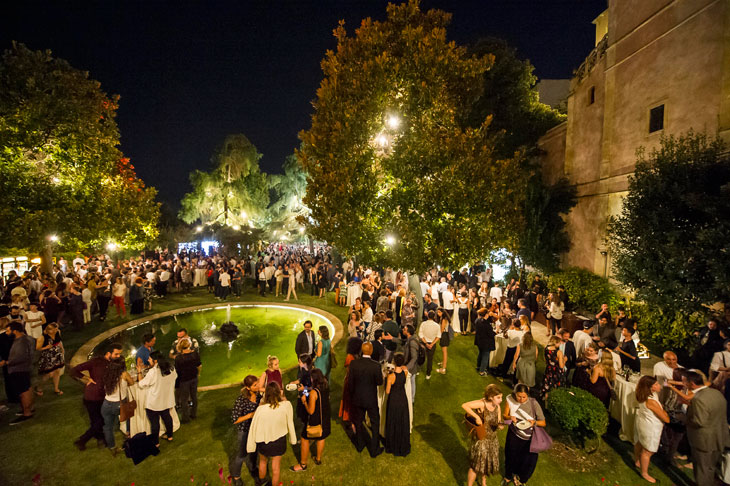In 1995, the fourth Istanbul Biennial took the theme ‘Orient/ation: The Vision of Art in a Paradoxical World’. Curated by René Block, it featured the likes of Marina Abramović, Anish Kapoor and Sigmar Polke in a city that was still relatively unknown to the art world. It was a prescient choice of topic: Istanbul’s art scene did indeed go on to transform under paradoxical conditions. Unexpected twists are always around the corner in Turkey. By the next edition in 1997, a ‘postmodern coup’ had occurred and the prime minister had resigned. Today, the political situation is complex in different ways. And yet, the Istanbul Biennial carries on, with the latest, 15th edition opening this week.
Olaf Metzel’s work at the 15th Istanbul Biennial. Photo: Sahir Ugur Eren
2016 seemed a lost year for Turkish tourism. A string of terrorist attacks was followed by the failed coup in July, after which a State of Emergency was imposed which remains in place today. The subsequent 10 per cent decline in foreign arrivals that year was felt strongly in many sectors, but interest in Turkey’s artistic offering did not take as much of a dip. Turkish artists are still being shown and acquired internationally: Cevdet Erek’s sound installation was a memorable addition to the Venice Biennale; Tate Modern’s Fahrelnissa Zeid retrospective brought a female pioneer of abstract art out of the shadows; growing commercial interest from the Middle East is evident in the participating galleries and collectors attending this September’s Contemporary Istanbul Art Fair, whose new director is the Iranian-born, London-based collector and patron, Kamiar Maleki.
There is cause for optimism in Istanbul itself. Security concerns spooked some international galleries and collectors (the 2016 edition of Contemporary Istanbul welcomed 29 international galleries, down from 65 the previous year), but the effects have now largely played out. Some local galleries have closed, such as Rampa, but others have expanded: the gentrifying Dolapdere neighbourhood hosts new branches of Dirimart and Sanatorium galleries, which will eventually be neighbours to the Koç Contemporary Art Museum, an initiative of the same foundation that runs the city’s Arter space for art. The Istanbul Modern is undergoing expansion. Serdar Bilgili recently installed 4,910 sq m of photography across his neighbourhood in what may yet earn the Guinness Record for the ‘World’s Largest Outdoor Photo Exhibition’. Provided some stability now, a more mature and varied art scene may be emerging – one that has ridden the 2010 boom and the 2016 bust. As Arter’s media coordinator Üstüngel Inanç put it in an interview earlier this month: ‘We respond well to adversity – the local art scene has proved it during the past decade.’
The 15th Istanbul Biennial. Photo: Ilgin Erarslan Yanmaz
The biggest obstacle for this year’s biennial is undoubtedly the ambiguous but weighty cloud of political, cultural, and psychological strain that lingers from last year. ‘I think we would all admit 2016 was a stand-out year in recent world history. We witnessed horrifying terrorist attacks, rising nationalism and the heart-breaking refugee crisis,’ says biennial director Bige Örer. ‘In such moments – when large crises strain society – we thought it best to slow down, talk to people, contemplate our practice, and then continue to do what we know best, as a gesture of resistance.’
Good curation looks to have done much to orient this biennial despite its turbulent moment. In charge this year are the Danish artist duo Elmgreen and Dragset, whose chosen theme ‘A Good Neighbour’ has a particular resonance. ‘Their theme is a lament for today’s world, but one which includes a subtle kind of humour,’ in Örer’s view. The concept is relevant, engaging for locals and visitors alike, and it spills beyond the boundaries of the biennial. Every Monday, writers, editors, curators and artists write around the theme in a dedicated blog on a Turkish digital newspaper, T24. Graphic posters that pose a question in response to the theme (‘is a good neighbour… one that you rarely run into?’) are available to pick up free of charge from Istanbul Foundation for Culture and Arts box offices across the city: some locals have taped them to their windows in an unintentional echo of the window-to-window conversations that resound in traditional Istanbul neighbourhoods.
‘A good neighbour’ is also, no doubt, what the curator duo and the biennial director hope the international community will be to Turkey’s artists and art industry at this time. Cultural activities were interrupted last year, and this is seen as a chance at regeneration. Örer wants the exhibitions ‘to stand against the idea of isolation,’ to encourage people to see the continuities between cultures over and above the ruptures. This new vision of art in a paradoxical world, is one of ‘artists across different geographies coming together to share traumas […] and generate hope.’ No quick task, but stranger things have been set in motion with a knock on a neighbour’s door.
The 15th Istanbul Biennial runs from 16 September–12 November.
